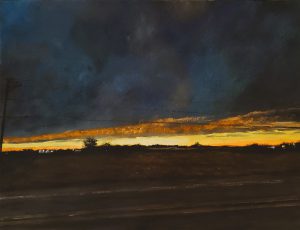
Roadside Reverence by Thad DeVassie
SNOOZE
David Clémenceau
One morning, while I was getting ready to take my son to kindergarten, I was listening to the radio on my smartphone. Between two Wednesday morning news breaks, there was a short pop science chronicle about why the snooze button in our alarm apps should be banned. The speaker quoted a recent study saying the snooze button reduced worker morale and everyday productivity.
My mind pretty much logged out after that and I didn’t listen to the end of the programme. But it summoned one of my very first memories of a snooze button.
I got my first digital alarm-clock from my mum for Christmas, when I was fourteen years old. She’d grown tired of getting me out of bed every morning – a painful process which usually included the lights being brutally switched, my blanked being pulled, an open window and freezing cold air. I hated getting up in the morning.
First, I had one of those cruelly indifferent, soulless BEEP BEEP BEEP alarms with two AA batteries. At the time, Donald Duck’s bell alarm would have been like birds singing on a balmy Sunday afternoon to me. I asked my mum for a more humane start into the day and got a radio alarm-clock the next Christmas.
The device completely revolutionized my wake-up routine, although I still hated getting up early. Aesthetically, it looked like the one in Groundhog Day, only all black and more 1990s bulky with soft sleek lines. It had had a large pre-LCD display with large, gleaming green digits. I loved watching it before falling asleep. But the clue was, of course, the radio function. I could set the alarm, wake up to the sound of music – and press snooze. I didn’t get up earlier nor was I more on time than before but it certainly felt differently.
As a child, my parents had nurtured me with Vivaldi and Chopin. But fate had it that, growing up in the 1980s and 1990s, I preferred Peter Tosh and Michael Jackson, while Roxette was my first musical crush. I can still hear Gun-Marie Fredriksson and Per Gessle chanting the refrain of “She’s got the look”. Joyride was the first CD I bought from my pocket money.
While I was listening to pop-rock and its emerging by-products, hip hop was also growing in popularity during the late 1990s. It became part of discovering my own musical tastes and my identity as a young teenager. At some point, I developed an interest in Bob Marley, his music and life and the ideological and cultural implications of Reggae. I even did a presentation in class about Rastafarianism because I’d heard about it on the radio.
One night, I couldn’t sleep and was bored to death. I’d been in bed since 8 pm and the time was drawing close to 10 pm. To put an end to my misery, I pressed the radio button on my alarm. Naturally, I had lowered the volume to the minimum beforehand, so that my mum wouldn’t hear. Then, I turned it up again very carefully until I could just make out what was being broadcast.
My favourite station played mainly hip hop and had an open-mic teen-psychology show from 9 pm to 10 pm. When it was over, I still wasn’t sleepy. I toggled the tuner dial on the side past some stations which didn’t hold my interest until something caught my attention. It was old music. Not classical music, but rock music.
The show was called The Story of Rock and had just begun airing. I had tuned in during the first episode. It immediately and completely pulled me into a world of history, culture, politics and – music.
For one glorious hour, Monday to Friday night from 10 pm to 11 pm, I listened to the events that had marked Britain, the USA and many other countries throughout the 20th century and which had contributed to the emergence of jazz, blues and rock ’n’ roll.
I enjoyed the stories of Jelly Roll Morton, Chuck Berry and David Bowie so much that I never saw the time pass even once. During that fantastic hour, I forgot about everything else, school, my friends, my parents, everything. I just stared at the display and traveled along the revelations and discoveries of each episode on a flying carpet that was the narrator’s voice. It was like magic to me.
The radio show about the snooze button, or function, on my mobile phone that morning brought back that dusty memory from twenty years before. The Story of Rock had stuck with me for so many years I couldn’t help but wonder why. Maybe it was the first time I learned something that really interested me.
#
Many years later, a group of students asked me why I always wore those funny print t-shirts. I told them I did because I felt comfortable wearing them and I enjoyed the pop-culture references they conveyed since they represented my own interests.
There wasn’t any formal dress code at the university where I taught German for a few years and since I’d made a fair collection over the years, I used to wear a different t-shirt each day. Sometimes I tried to use them as incentives for my students to do a short presentation class. But that was more a teaching side effect.
One student of the group then asked, quite unimpressed, what point there was in culture. Before I could answer, he added it was boring and useless in everyday life.
I had to admit he had a point. Knowing stuff about pop-culture or any type of culture was useless in and of itself. I realized at the same time that I’d never asked myself that question. And I didn’t know any answer either.
But I didn’t want to leave the group without at least trying to find one. I asked the students what stories they liked. An awkward moment followed because in their minds, stories were for little children and they weren’t children anymore. Someone said he didn’t like any stories at all. Someone else said she’d seen all the X-Men films.
So had I. After a brief moment of thinking, I speculated that perhaps the point was being able to share. We parted ways on that note but I wasn’t really satisfied. The question stuck with me.
On my way home, I realized that had I been a quicker, I could have told them that knowing all the X-Men was already culture, even though they didn’t perceive it as such.
#
While I was getting dressed that morning, I remembered the radio show which I had almost forgotten about. Even though it had been buried somewhere in my memory, it was still there. It had stuck with me, like the question the student asked, and I still felt somehow dissatisfied with my answer.
My son came into the room. He was still a toddler, then, and just beginning to speak. He looked at me and waddled across the room, radiating an infant’s unbridled curiosity for something he’d just noticed for the very first time. I realized what it was when his stubby little finger connected with the t-shirt I’d just put on. As he stood in front of me pointing his finger at Chewbacca, I suddenly thought that besides sharing, perhaps transmission was another reason to dig culture.
It was a Star Wars fan print with nine characters from the franchise. I could see he was waiting for me to explain what it meant. So, I pointed at the same photo as he and said, “This is Chewbacca. This is Leia. This is C3PO.” And he began to repeat, “Toobaka.”
David Clémenceau is of French and German origins and has an MA in translation. His work has been published in print and online in the USA, the UK, Canada and India. His short stories can be found, among others, in Soteira Press, Tigershark Magazine, the Spadina Literary Review and Nzuri Journal of Coastline College. He lives in Germany where he teaches secondary school English. He thinks and writes mostly in English and likes to read everything from Pratchett to Asimov.
Thad DeVassie is a multi-genre writer and fine art painter who creates from the outskirts of Columbus, Ohio. He is the author of SPLENDID IRRATIONALITIES, which was awarded the James Tate International Poetry Prize in 2020 (SurVision Books), and YEAR OF STATIC, a chapbook containing original paintings and micro prose (Ghost City Press, 2021). More of his written and painted works can be found at www.thaddevassie.com.
